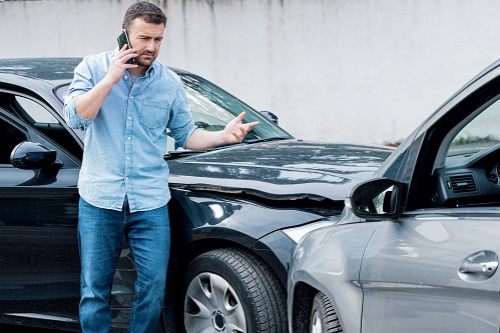- What does self-insured mean?
- Can you self-insure your car?
- How does self-insurance work?
- Who is self-insurance for?
- How much does it cost to self-insure a car?
- Legal and state requirements for self-insuring a vehicle
- How to self-insure your car
- Pros and cons of Self-insured car insurance
- How does the claims process work?
- Self-insured car insurance: FAQ
What does self-insured mean?
Self-insurance means you assume full financial responsibility for damages or injuries you may cause while driving. While traditional insurance is a good choice for most drivers, some self-insure to save money on insurance premiums. Self-insurance for your car is a significant financial responsibility, where you are solely responsible for damages and injuries that result from an accident. In most states, you must show that you are financially able to pay a claimAn insurance claim is a request you make to your insurance company for coverage after your car is damaged or you have an accident. You can file a claim online, by phone, or in writing. by having a specific amount of money available.
“Self-insuring your vehicle can seem like a cost-saving measure, but it carries significant financial risks. The primary concern with self-insurance is the transfer of financial responsibility from an insurance company to the individual,” says Jerry Bump, acting insurance commissioner, State of Hawaii Department of Commerce and Consumer Affairs.
“This means that in the event of an accident, you would be personally liable for all associated costs, including vehicle repairs, medical expenses, and potential legal fees. Such expenses can be substantial and may lead to financial hardship if you are not adequately prepared for them. Given these risks, it's crucial to carefully assess your financial capacity and risk tolerance before opting to self-insure your vehicle,” he says.
With traditional auto insurance, you pay an insurer a premiumThe payment required for an insurance policy to remain in force. Auto insurance premiums are quoted for either 6-month or annual policy periods., and it provides a predetermined amount of coverage. For example, if you carry $50,000 in property damage liability coverage and hit another vehicle, your insurer pays damages up to the $50,000 limit.
However, with self-insured coverage, if you hit another vehicle, you’re entirely responsible for any damages, no matter the cost. Drivers may choose to self-insure to avoid costly insurance premiums. However, most drivers don’t have the funds to set aside, making self-insurance risky.
Can you self-insure your car?
Although most states require drivers to carry at least a minimum amount of car insurance, some states allow you to self-insure your vehicle if you meet specific financial requirements. This typically requires a large sum of money set aside for claims.
Additionally, many states allow you to self-insure if you have a fleet of vehicles, such as for a business. Only a handful of states allow individuals with a few cars to self-insure. If you only have one or two vehicles, it may be challenging to go the self-insurance route.
How does self-insurance work?
Self-insurance allows you to set aside funds or buy a bond to pay damages instead of filing an insurance claim.
If your state allows self-insurance, specific financial requirements must be met. Otherwise, you’ll be considered driving without insurance, leading to fines and higher car insurance rates when you reinstate coverage.
Every state except New Hampshire requires drivers to carry a minimum amount of car insurance. Each state’s self-insurance requirements differ, as does the amount of money you must set aside. Understanding and adhering to your state's specific rules is crucial, as failure to do so can result in fines and other legal issues.
To get self-insurance, you’ll have to provide one of the following:
- A cash deposit. You’ll need an account with a specific amount set aside, which varies by state. You can’t use this account for any other purpose, and failure to keep the required minimum may result in you being considered uninsured.
- Self-insurance certificate. You must prove you have enough capital to cover claims, such as car repairs, injuries and legal fees. Businesses with a vehicle fleet or wealthy people with a car collection usually fall into this category.
- Surety bond. If you don’t have enough money to set aside for claims, you can get a surety bond. If you cannot pay for the damages, the bond company agrees to pay them, and then you repay them. Your state insurance department will have a list of surety bond companies you can contact.
In many cases, the amount of money that must be set aside is equal to the state's minimum insurance requirement. Since requirements vary significantly by state, you’ll need to contact your state’s insurance department to learn how to self-insure your car.
Who is self-insurance for?
While self-insurance may seem like a way to avoid high car insurance premiums, it's not a viable option for most drivers. However, there are some cases where it can be beneficial.
Drivers with a high net worth or strong financial safety net may find self-insurance a good option. Since the upfront costs are significantly higher than an insurance premium, only drivers who can afford a financial hit should consider self-insuring their car. Remember, not only do you need the money to cover your damages and injuries, but you also need to be able to cover property damages and injuries to others if you cause an accident.
Businesses with a fleet of vehicles may also find self-insurance a good option. It may be more cost-effective to pay for accidents than traditional insurance for multiple cars. For example, if one fleet vehicle causes an accident and the payout is $10,000, it’s cheaper than paying for car insurance on 25 vehicles. Additionally, businesses may have the reserve capital to meet state requirements.
When self-insurance might not be a good idea
For most drivers, self-insurance isn’t a good idea. Even if you can set aside the significant amount of money your state requires, you’re still open to significant financial and legal risks. A single accident could lead to potential lawsuits and financial ruin.
For example, let’s say you live in Connecticut and are self-insured. The state requires that you set aside $50,000 in case of an accident. You cause an accident that totals a Mercedes and sends two people to the hospital with injuries. You’ve exhausted that $50,000 and then some. You’re now financially responsible for any property damages and injuries that result from the accident. In addition to financial risks, you’re also open to potential lawsuits.
“Self-insuring a personal vehicle in Connecticut is not a simple process and could carry significant financial risk. Individuals must meet strict financial requirements, post a bond, and manage all claims themselves, often by hiring outside help,” says George Bradner, assistant deputy commissioner and property and casualtyLiability or loss resulting from an accident. director at the Connecticut Insurance Department.
“Coverage for things like vehicle damage, towing, or legal representation will be out of pocket, and if a claim exceeds the bond amount, the individual could be personally liable. Self-insurance is more suitable for large companies, corporations, or municipalities,” he says.
Only drivers and businesses who can afford the financial and legal risks should consider self-insuring.
PEOPLE ASK
Why is self-insurance for risks involving your car or home not feasible for most Americans?
Self-insurance requires significant financial responsibility that most drivers can’t meet. Additionally, it opens drivers to substantial financial and legal risks that may not be in their best interests.
How much does it cost to self-insure a car?
States that allow drivers to self-insure typically require a minimum amount of car insurance to be set aside. However, requirements vary significantly from state to state.
For example, California requires drivers to self-insure with $75,000 in cash or a surety bond, while North Dakota requires $155,000 per vehicle.
In addition, drivers may have to pay application and notary fees. Contact your state’s insurance department to learn the self-insurance process and financial requirements.
Legal and state requirements for self-insuring a vehicle
Most states allow some form of vehicle self-insurance. However, the financial requirements and who can self-insure vary significantly.
"North Dakota law, along with most other states, allows individuals and companies to self-insure their property and possessions. However, significant requirements ensure that those seeking this route have the financial resources to meet the obligations that insurance would typically cover. For most people, traditional insurance remains the safest and most practical way to protect themselves," says Godfread.
The table below shows the states that allow self-insurance and each state’s requirements.
| State | Number of vehicles required | Minimum financial requirement |
|---|---|---|
| Alabama | 25 or more vehicles | Not specified |
| Alaska | 25 or more vehicles | $125,000 |
| Arizona | 10 or more vehicles | Not specified |
| Arkansas | 25 or more vehicles | Not specified |
| California | 1 or more vehicles | $75,000 |
| Colorado | 25 or more vehicles | $65,000 |
| Connecticut | 1 or more vehicles | $50,000 |
| Delaware | 15 or more vehicles | Ability to satisfy $1.5 million in claims |
| Florida | 1 or more vehicles | $40,000 net worth |
| Georgia | 1 or more vehicles | Cash deposit of $100,000 with an additional $300,000 of authorized investments |
| Hawaii | 1 or more vehicles | $90,000 |
| Idaho | 25 or more vehicles | $500,000 net worth |
| Illinois | 25 or more vehicles | Not specified |
| Iowa | 25 or more vehicles | Not specified |
| Kansas | 25 or more vehicles | $100,000 |
| Kentucky | 1 or more vehicles | $50,000 for the first vehicle, plus $10,000 for each additional vehicle |
| Louisiana | 25 or more vehicles | $10,000 net worth for each insured vehicle |
| Maine | 1 or more vehicles | Not specified |
| Maryland | 25 or more vehicles | Not specified |
| Massachusetts | Not specified | Not specified |
| Michigan | 25 or more vehicles | Not specified |
| Minnesota | 25 or more vehicles | $5 million net worth |
| Mississippi | 25 or more vehicles | Not specified |
| Missouri | 26 or more vehicles | 3 years of financial records |
| Montana | 25 or more vehicles | $55,000 |
| Nebraska | 26 or more vehicles | $75,000 |
| Nevada | 10 or more vehicles | $55,000 for up to vehicles, then the deposit increases based on the number of vehicles |
| New Hampshire | 1 or more vehicles | $100,000 per vehicle |
| New Jersey | 25 or more vehicles | 3 years of financial records |
| New Mexico | 1 or more vehicles | $60,000 |
| New York | 25 or more vehicles | Not specified |
| North Carolina | 25 or more vehicles | Not specified |
| North Dakota | 1 or more vehicles | $155,000 per vehicle |
| Ohio | 26 or more vehicles | $100,000 net worth |
| Oklahoma | 25 or more vehicles | Not specified |
| Oregon | 25 or more vehicles | $185,000 in funds available |
| Pennsylvania | 1 or more vehicles | $50,000 for the first vehicle, plus $10,000 for each additional vehicle |
| Rhode Island | 25 or more vehicles | $75,000 |
| South Carolina | 25 or more vehicles | $3,000 per vehicle or $20 million net worth |
| South Dakota | 1 or more vehicles | $175,000 |
| Tennessee | 25 or more vehicles | Not specified |
| Texas | 25 or more vehicles | Not specified |
| Vermont | 1 or more vehicles | $115,000 |
| Virginia | 21 or more vehicles | $125,000 |
| Washington | 26 or more vehicles | $60,000 |
| Washington, D.C. | 25 or more vehicles | Not specified |
| West Virginia | 25 or more vehicles | $1 million in assets |
| Wisconsin | 25 or more vehicles | Not specified |
| Wyoming | 25 or more vehicles | $200,000 plus $100 for vehicles over 25 |
How to self-insure your car
Each state determines its self-insurance process, so you’ll need to contact your state’s insurance department to find the exact steps required to register as a self-insured driver.
However, steps in the self-insurance process typically include:
- Contacting the state insurance department to let them know you plan to self-insure
- Setting up a bank account or surety bond in the amount required by your state
- Gathering documents needed, such as your car registration, driver's license and a notarized document detailing your monetary requirement
- Pay application fees
- Learn the renewal process, which usually includes having your bank statement or surety bond notarized for the following year
Pros and cons of Self-insured car insurance
Before deciding if self-insuring your car is right for you, consider the pros and cons.
Pros:
- No insurance premiums
- If there's no accident, you keep your money
- No insurance company monitoring your driving record
Cons:
- Significant financial risk
- Opens you to lawsuits
- A large amount of money must remain in a specific location
How does the claims process work?
If you self-insure, you’re solely financially responsible for your vehicle, injuries and damages and injuries of others if you cause an accident. Unlike traditional insurance, you can’t rely on your insurance company to handle a claim.
First, get a police report. Whether it’s theft, vandalism, or an accident, you need to report it to the police so that there’s a documented report.
Next, you are responsible for scheduling any estimates and repairs to your vehicle or someone else's. Whether a car needs to be repaired or replaced, the financial burden is yours.
Finally, if you cause an accident, you are responsible for the medical costs for yourself, your passengers or people in another car.
If another person or driver is involved, you will need to work with them to receive and pay any related bills. Not only does this take a significant amount of time, but you’re also open to lawsuits should the other person not be happy with the amount you’re willing to pay.
Self-insured car insurance: FAQ
Can you write off self-insurance expenses?
Drivers who use their vehicles only for work-related purposes may be able to deduct a portion of their car insurance premiums. A tax advisor can determine if the money you set aside for self-insurance can be deducted from your taxes.
Are there other alternatives to car insurance?
Drivers typically have to choose between traditional and self-insured car insurance. Non-owner car insurance, which offers minimum coverage, is the only other option for drivers without a vehicle.





